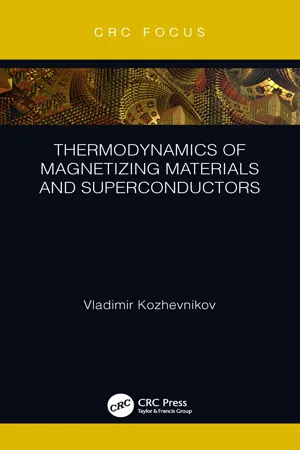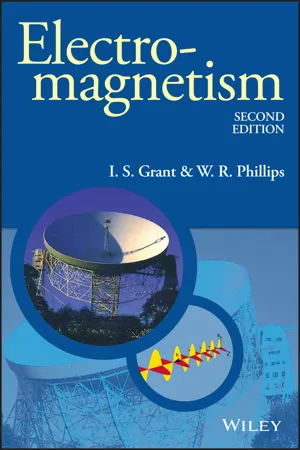Physics
Energy in a Magnetic Field
Energy in a magnetic field refers to the potential energy associated with the orientation of magnetic dipoles in a magnetic field. When a magnetic dipole is placed in a magnetic field, it experiences a torque that aligns it with the field, resulting in potential energy. This energy is proportional to the strength of the magnetic field and the orientation of the dipole.
Written by Perlego with AI-assistance
Related key terms
Related key terms
1 of 4
Related key terms
1 of 3
3 Key excerpts on "Energy in a Magnetic Field"
- Vladimir Kozhevnikov(Author)
- 2019(Publication Date)
- CRC Press(Publisher)
specimen. It can be viewed as energy of interaction of the applied magnetic field with the specimen magnetic moment induced by this field.In electrostatics, an expression similar to (2.25 ) is work done by the electric field to polarize the specimen which equals potential energy (such as energy of elastic deformation of molecules due to induced electric dipole moment) stored in this specimen plus energy of the electric field caused by the polarized specimen [3 ]. In magnetostatics Emis work done by the magnet power supply to magnetize the specimen equal to variation of kinetic energy of the bound electrons due to precession of their orbits5 induced by the applied magnetic field. In case of non-cylindrical and non-transverse geometries, Emalso includes energy of the outer field created by the magnetized specimen.Let us look at how it happens in a diamagnetic specimen of cylindrical geometry. For simplicity, we take the specimen consisting of non-interacting single-atomic (hence spherically symmetrical) molecules.Under the influence of the magnetic field, electrons in atoms precess with Larmor angular velocity o which iso = − γ H ,where γ = e/2mc (e/2m in SI units) is gyromagnetic ratio of the orbiting electrons.Hence, linear velocity of each electron vi(velocity when no field is applied) changes for Δvi= o × Ri, where Riis radius of the electron orbit.As a result of precession, in accordance with the Lenz law, the sample acquires a negative magnetic moment, the density of which is I = χH, as defined by (1.19 ). Classical Langevin expression for the magnetic susceptibility χ (see, e.g., [16 ] for derivation) isχ = −N Ze 26 mc 2,R 2¯(2.26) whereis mean square radius of the electron orbit6 , N is number of molecules per unit volume and Z is the number of electrons in each molecule.R 2¯On the other hand, the change of electrons’ velocities implies that kinetic energy of electrons in each molecule Tmchanges for ΔTm, which isΔT m=m 2∑[ (i = 1Zv i+ Δv i) 2−v i 2] =m 2∑[ 2i = 1Zv iΔ v- eBook - ePub
- Kenneth W Ford(Author)
- 2016(Publication Date)
- WSPC(Publisher)
2 /8π is always the same as the potential energy calculated from the work required to move the charges and create the fields.Not surprisingly, a similar expression, 2 /8π, gives the energy per unit volume stored in the magnetic field. The general connection between fields and energy isIf is expressed in gauss and in dynes/e.s.u. (or, equivalently, statvolts/cm), the right side gives the energy density in ergs/cm3 . In a propagating electromagnetic wave, with electric and magnetic fields in perfect balance, the two terms on the right are equal in magnitude. The energy of the wave is half electric, half magnetic.At the most fundamental level, we recognize now only three kinds of energy: kinetic energy, field energy, and mass energy. Electric and magnetic and gravitational potential energy have been accounted for as field energy. Heat energy is kinetic energy. Light energy is electromagnetic field energy. Chemical energy is a complicated mixture of the kinetic energy of atomic electrons and the field energy associated with the atomic electrical forces. There is some reason to speculate that the future may see a reduction to only one kind of energy—field energy. If mass proves to be only an intense localized bundle of field energy, as it may, then kinetic energy too (mass in motion) will be a form of field energy. Already we know that changes of field energy are reflected in changes of mass, so that in balancing the energy books in elementary-particle processes, it is usually sufficient to consider only mass and kinetic energy. - eBook - ePub
- I. S. Grant, W. R. Phillips(Authors)
- 2013(Publication Date)
- Wiley(Publisher)
21 . The sign of the middle term may be either positive or negative depending on whether the current in one coil increases or decreases the flux through the other coil, i.e. on whether the fields from the two coils add up or not.6.3.3 The potential energy of a coil in a field and the force on the coil
Let us now consider the torques and forces on a circuit which carries a fixed current I 1 and is placed in an external field arising from a fixed current I 2 in another coil. The same problem was discussed in section 4.6.1, where expression (4.52) was obtained for the potential energy U P of coil 1 in the field B2 of coil 2,(6.29)where S 1 is a surface whose rim is the contour of coil 1. In terms of the mutual inductance M 12 between the two coils, the magnetic flux through coil 1 is given by(6.30)The sign in Equation (6.30) is the same as in Equation (6.28) and is determined by requiring the direction of the vectors dS to be given by the direction of the current I 1 and the right-hand screw rule. Combining Equations (6.29) and (6.30 ),(6.31)The total magnetic energy of the system, given by Equation (6.28) contains terms representing self-energies and involving self-inductances, and an interaction energy ±M 12 I 1 I 2 . The potential energy of one coil in the field of the other, given by Equation (6.31) , is equal to M 12 I 1 I 2 . The potential energy U P is related to the mechanical work done by the system if a coil moves under the influence of the magnetic forces. If one coil undergoes a displacement dr under the influence of a magnetic force F, the mechanical work done by the system dW is given by(6.32)The force F is given byas given in section 4.6.1. During the displacement dr the batteries supplying the currents I 1 and I 2 do work dW b against the induced e.m.f.s in order to maintain the currents constant.where dΦ1 and dΦ2 are the changes in flux through the circuits during the displacement dr. This result follows from Equation (6.26) . If the currents are constant the change in the total magnetic energy of the system is obtained from Equation (6.27)
Index pages curate the most relevant extracts from our library of academic textbooks. They’ve been created using an in-house natural language model (NLM), each adding context and meaning to key research topics.
Explore more topic indexes
Explore more topic indexes
1 of 6
Explore more topic indexes
1 of 4


